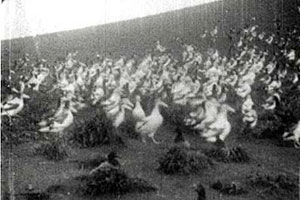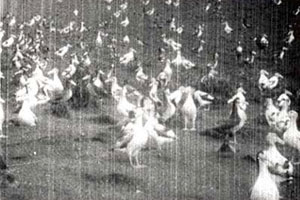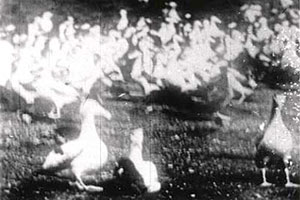- Home >
- Short-tailed Albatross >
- history of Albatross
Short-tailed Albatross
History of Torishima and Short-tailed Albatross
Update: June 16, 2017
This page introduces Torishima in the Izu Island chain, where the Yamashina Institute for Ornithology has been conducting the Short-tailed Albatross conservation activities. It also introduces the history of population decline and rediscovery of the Short-tailed Albatross and the population recovery until the start of the decoy mission.
Geography of Torishima
Torishima is located in the south end of the Izu Island chain in the Pacific at 30°29′N and 140°18′E. It is located approximately 600km to the south of Tokyo and is approximately 300km south of Hachijo Island. There is Mukojima of Ogasawara Island chain approximately 370km south of Torishima.
Torishima is approximately 2.5km across and is about 7km around. It is a volcanic island and just the peak of the double volcano appears above the sea. The highest is the Mt. Iou which has the height of 394m. The island as a whole is designated as the national natural treasure (natural protection area).
Short-tailed Albatrosses existed in uncountably numerous numbers
Even in the Edo era (1603 - 1868), when construction of large ships was prohibited due to the national isolation policy making navigation to outer-sea very difficult, people knew that there was an island in the southern part of Izu Islands where numerous numbers of Short-tailed Albatrosses existed. Such information came from the stories of sailors who were drifted but made home alive. In documents from the latter period of the Edo era, it was recorded that numerous white birds soar into the high sky in the southern sea of Hachijo Island, which looks like a white pillar rising from the ocean and is called "Tori-Bashira (Bird Pillar)". Well-known drifters to Torishima include Manjiro (later Manjiro Nakahama), famous fisherman of Tosa in the novel "Jon Manjiro Hyoryuki (John Manjiro, the Cast-Away: His Life and Adventures)" written by Ibuse. He was also one of the drifters who survived by eating albatrosses.
The first scientific report on the Short-tailed Albatross in Torishima was written in the middle of the Meiji-era. It is "Torishima Bakadori no Hanashi (Story of the Fool-bird in Torishima)" written by the explorer Toru Hattori who visited Torishima in 1888. In this report he describes Torishima and how numerous Short-tailed Albatrosses occurred on the island. He explained that it was "truly incredible".
Beginning of feather harvesting
Why did the Short-tailed Albatross that existed in great numbers disappear to almost extinction? It is because they were killed by humans for harvesting feathers. Short-tailed Albatrosses are large water birds and produce large amount of good-quality feathers. They cannot easily take wings once they land, thus it is easy to kill large numbers at once on the island where they nest in colonies. Torishima was suited for a feather harvesting business. The key figure in this albatross culling was the businessman Han-emon Tamaoki (1830 – 1911). He landed on Torishima in 1886 and established Tamaoki Shokai (Tamaoki Company) the next year. He carried out a systematic feather harvesting until he withdrew from the island in 1922. His feather harvesting was exhaustive. He had 300 people living on this small island by 1900 and had built schools and light railway for transporting harvested Short-tailed Albatrosses. It's also been recorded that one worker culled about 100 to 200 Short-tailed Albatrosses a day. The report on the reduction of Short-tailed Albatrosses written by Yoshimaro Yamashina, the founder of the Yamashina Institute for Ornithology, records that at least 5 million Short-tailed Albatrosses were culled by 1902.
The feathers harvested from short-tailed albatrosses were exported as materials used for feather beds, down quilt and pillows. At that time in the Meiji-era the policies of the country was to increase wealth and military power and to encourage new industry. Feather harvesting was one of the important exporting industries. The feathers of short-tailed albatrosses are white colored and were traded at higher price compared to feathers of other birds. The remaining bodies of albatrosses were used to produce oil or made into fertilizer.
Steep decline in albatross population
Due to the systematic feather harvesting, Short-tailed Albatrosses that existed in large numbers began to decline its population by the end of the Meiji-era (beginning of the 20th century), and the population dramatically declined in the Showa-era (1926-1989). The conservation measures were launched in the end of the Meiji-era, but they didn't prove to be effective on the isolated island. Yoshimaro Yamashina visited Torishima in 1930 and recorded the number of Short-tailed Albatrosses on the island to be approximately 2,000. Yoshimaro Yamashina was devastated by the sharp decline in the population and began to scramble for hunting prohibition in Torishima. Even after this, Nobuo Yamada who was sent to the island by Yoshimaro Yamashina recorded the declining number of Short-tailed Albatrosses, a couple of hundreds in 1932, and less than a hundred in 1933. Torishima was designated to be a hunting prohibited area in 1933. However, it is said that last-minute mass hunting was carried out immediately before the designation.



Torishima Island photographed by Yoshimaro Yamashina in 1930
Due to a decrease in the population of short-tailed albatrosses, Han-emon Tamaoki withdrew from his business in Torishima in 1922. The island became uninhabited for a few years until Shusaku Okuyama (1894-1978) began exploiting the island from 1927 to 1939. His business focused mainly on cattle pasturing but also harvested feathers from Black-footed Albatrosses Phoebastria nigripes and Tristram's Storm-petrels Oceanodroma tristrami instead of Short-tailed Albatrosses that no longer existed abundantly.
Torishima's volcano erupted in 1902 and in 1939. The eruption in August 1902 killed all of 125 people living on the island who were working in the feather harvesting business under the Tamaoki Company. Han-emon Tamaoki survived from this eruption as he was not on the island at that time, and restarted his business again the next year. The second eruption occurred in August 1939 but approximately 30 people living on the island at that time had evacuated from the island and were safe.
Outside of Torishima
It is known that the Short-tailed Albatross used to breed on several islands in the northwestern Pacific other than Torishima. These islands included Mukojima Islands in Ogasawara Island chain, Senkaku Islands and Daito Islands in Okinawa, Pengjia Islet in the north of Taiwan, and Penghu Islands in the west of Taiwan. It is a known fact that feather harvesting was also carried out in several of these islands but it appears that Short-tailed Albatrosses in these islands disappeared around the same time as Torishima without their population being ever documented. Currently Senkaku Islands (Kita-kojima and Minami-kojima) are the islands other than Torishima where Short-tailed Albatrosses can be found.
So-called "Extinction declaration" and rediscovery
A radar base of the navy was installed in Torishima Island during the World War II, but the status of the Short-tailed Albatross at the time is not known. The first person who visited the island to study the Short-tailed Albatross after the war was Oliver Austin, Jr. (1903-1988), an American who resided in Japan as an ornithologist of the General Headquarters Supreme Commander for the Allied Powers. He traveled to the southern Izu Islands and the northern Ogasawara Islands from March to April of 1949 and observed from the boat numerous islands including Torishima. He was not able to land on the Torishima Island due to bad weather, but he thoroughly observed the island from offshore and announced that it was likely that Short-tailed Albatross was extinct. This is the so-called "extinction declaration".
After the World War II, Ogasawara Islands was placed under U.S. rule and Torishima became an important frontline base for observation of typhoons. Torishima meteorological observatory of the Central Meteorological Observatory (Japan Meteorological Agency) was established soon after the war. Shoji Yamamoto from the observatory was patrolling the island in January 1951 when he discovered a small number of Short-tailed Albatrosses on the steep slopes of Tsubamezaki surrounded by cliffs. This news reached the ornithology world and was welcomed with great pleasure. Austin may have overlooked these albatrosses as they were in such few numbers, or perhaps because the surviving albatrosses were young when they spend a few years away from the island after they fledge and before they return to breed.
Status after rediscovery and conservation activities
After the rediscovery, observation and conservation activities of Short-tailed Albatrosses were carried out voluntarily by the staff of the Torishima meteorological observatory, and researchers visited the island using the limited boat service to the observatory and investigated the status of albatrosses. On the other hand, the Short-tailed Albatross was designated as a national natural treasure in 1958 and as a special natural treasure in 1962. The conservation activities by the observatory staff included elimination of wild cats, creation of nesting environment by transplanting a native grass Miscanthus condensatus in the breeding areas of Tsubamezaki. Yoshimaro Yamashina, who was highly concerned about the Short-tailed Albatross since before the war, sent researchers from the Yamashina Institute for Ornithology by the observatory boat almost every year in the beginning of the 1960s. The researchers investigated the status of the Short-tailed Albatross and attached bands on chicks' legs to study their migration. These activities ensured that Short-tailed Albatrosses continued their breeding every year although in small numbers, and information on their status was continually documented.
Torishima observatory that contributed greatly to the rediscovery and conservation of the Short-tailed Albatross withdrew from the island in 1965 and Torishima became uninhabited. A series of earthquakes were observed this year and a volcanic eruption was predicted. By this time, the Short-tailed Albatross population was slowly growing, with approximately 50 adult and about a dozen chicks a year.
With the closure of the meteorological observatory researchers were not longer able to land on the island to see the status of the Short-tailed Albatross. However in April 1973, Dr. W. L. N. Tickell, a British ornithologist, and Masashi Yoshii from Yamashina Institute for Ornithology visited Torishima by a British navy ship. They counted 24 chicks and confirmed that the albatross population was slowly growing.
Short-tailed Albatross Research commenced by Hiroshi Hasegawa
In the late 1970s Hiroshi Hasegawa of Kyoto University, (currently of Toho University) began his research on the Short-tailed Albatross. He counted eggs and chicks just before fledging and attached leg bands on chicks every year to calculate breeding success. Hasegawa found that breeding success was often below 50%, much lower than other birds from the albatross family, and suspected that it was because the steep slopes of Tsubamezaki, the breeding ground of albatrosses, was causing sliding of the volcanic surface soil making the surface vegetation very sparse. Together with his observation results, he concluded that such environmental condition was causing eggs and chicks to fall off from the nests or be buried by the sliding soils. Based on the conclusions made by Hasegawa, the Environment Agency (currently Ministry of the Environment) and the Tokyo Metropolitan Government began Miscanthus transplantation and erosion control works at Tsubamezaki breeding ground in 1981. As a result, fledging success increased in the year of the improvement project and continued increasing every year. However, it was noted that it took only a few years for the breeding ground to erode again, often reducing the breeding success. The environmental improvement project of Tsubamezaki was highly effective in increasing the Short-tailed Albatross population but it was not enough for Hasegawa and others to be optimistic about the future of the Short-tailed Albatross. It was in such settings that the concept of the Operation Decoy was proposed by Hasegawa.

